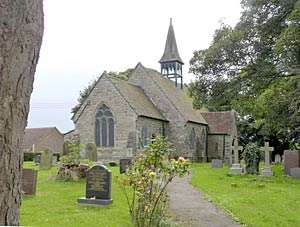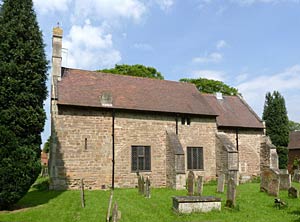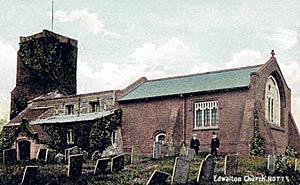< Previous | Contents | Next >
The Battle of the Idle

Eaton church in 2014.
© Copyright Alan Murray-Rust and licensed for reuse under this Creative Commons Licence
EATON. It lies two miles from Retford, a tiny village of a few red houses, a great house with lovely gardens and walls glowing with gold as we see it through the trees from the Great North Road, and a small grey stone church which has followed one of Norman days.
The church stands high in a churchyard where fine sycamores and a great horse-chestnut grow, looking down on the River Idle. A peaceful scene it was for us, with a flotilla of 30 geese on the stream flowing through the three-arched bridge, an ivied farmhouse on the other side, and woods and green meadows everywhere.
Yet this is the spot, it is believed, where more than 1300 years ago king met king in battle, one of them and the son of the other being slain. It was in 617 that the Battle of the Idle was fought in which Redwald of East Anglia slew Ethelfrith, the usurping king of Northumbria, but lost his own son Regnhere. Redwald had been sheltering Edwin, the true Northumbrian king, and as a result of the victory Edwin was restored to the throne. He married the beautiful Ethelburga, daughter of the Christian King of Kent, and was himself baptised by Paulinus.
The Great Sycamore Tree

Edingley church in 2014.
© Copyright Alan Murray-Rust and licensed for reuse under this Creative Commons Licence
EDINGLEY. Abounding in orchards, this trim little place between Southwell and Mansfield has a plain church which has something it has kept 800 years in spite of much change. It has lost a south aisle, but two wide arches and other fragments of its 14th century arcade are still seen in the wall; and though the chancel was made new last century it has its old piscina and the priest's doorway, which is now blocked. There is a Norman west doorway with chevron and cable mouldings, and a small Norman window deeply splayed in the north and south walls of the nave.
A stream runs by the churchyard gate, and just within is a tremendous sycamore overhanging the road and dwarfing a shapely little yew; the big tree shelters a patch of ground 76 yards round.
Tiny Church With Walls Aslant

Edwalton church, c.1905.
EDWALTON. Charming new houses and gardens line the busy highway, but the heart of the old village lies at the end of a leafy lane, three miles from Nottingham. Just beyond two delightful little homes in a garden (a memorial to the first Clerk of the County, Jesse Hind) is the old church enshrined in trees. Some of them make an evergreen avenue from a beautiful oak lychgate with a shingled roof.
Its story and its name are thought to go back to a Saxon settler named Eadweald, who reclaimed the land from a boggy marsh. With walls aslant and some of its windows askew, the tiny church is much changed since it was built about 800 years ago. The chancel collapsed in the 17th century, and the new one is of brick. The small red brick lower, diapered with black, is believed to be one of the rare examples of church building in the time of the terrible Mary Tudor.
A buttress of the aisle is 13th century. The bowl of the font, curiously shaped like a trough, may be as old, but its base is modern and its cover is Jacobean. An old hooded doorway lets us in, and between the nave and the very narrow aisle is a 14th century arcade. The brass lectern is the peace memorial, and rich glass of our day, showing one knight sheathing his sword and another kneeling at the Cross, is in memory of Colonel Arthur Brewill, DSO.
Rebecca Freeland, who lived through all but a century of history from the outbreak of the Civil War, has a slate in the churchyard with a curious epitaph.
